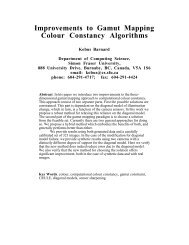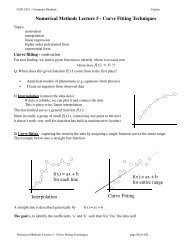1 Introduction
1 Introduction
1 Introduction
- No tags were found...
You also want an ePaper? Increase the reach of your titles
YUMPU automatically turns print PDFs into web optimized ePapers that Google loves.
1.2. Probability Theory 13Figure 1.10 We can derive the sum and product rules of probability byconsidering two random variables, X, which takes the values {x i} wherei =1,...,M, and Y , which takes the values {y j} where j =1,...,L.In this illustration we have M =5and L =3. If we consider a totalnumber N of instances of these variables, then we denote the numberof instances where X = x i and Y = y j by n ij, which is the number ofpoints in the corresponding cell of the array. The number of points incolumn i, corresponding to X = x i, is denoted by c i, and the number ofpoints in row j, corresponding to Y = y j, is denoted by r j.y jc i}n ijx i}r jand the probability of selecting the blue box is 6/10. We write these probabilitiesas p(B = r) =4/10 and p(B = b) =6/10. Note that, by definition, probabilitiesmust lie in the interval [0, 1]. Also, if the events are mutually exclusive and if theyinclude all possible outcomes (for instance, in this example the box must be eitherred or blue), then we see that the probabilities for those events must sum to one.We can now ask questions such as: “what is the overall probability that the selectionprocedure will pick an apple?”, or “given that we have chosen an orange,what is the probability that the box we chose was the blue one?”. We can answerquestions such as these, and indeed much more complex questions associated withproblems in pattern recognition, once we have equipped ourselves with the two elementaryrules of probability, known as the sum rule and the product rule. Havingobtained these rules, we shall then return to our boxes of fruit example.In order to derive the rules of probability, consider the slightly more general exampleshown in Figure 1.10 involving two random variables X and Y (which couldfor instance be the Box and Fruit variables considered above). We shall suppose thatX can take any of the values x i where i =1,...,M, and Y can take the values y jwhere j =1,...,L. Consider a total of N trials in which we sample both of thevariables X and Y , and let the number of such trials in which X = x i and Y = y jbe n ij . Also, let the number of trials in which X takes the value x i (irrespectiveof the value that Y takes) be denoted by c i , and similarly let the number of trials inwhich Y takes the value y j be denoted by r j .The probability that X will take the value x i and Y will take the value y j iswritten p(X = x i ,Y = y j ) and is called the joint probability of X = x i andY = y j . It is given by the number of points falling in the cell i,j as a fraction of thetotal number of points, and hencep(X = x i ,Y = y j )= n ijN . (1.5)Here we are implicitly considering the limit N →∞. Similarly, the probability thatX takes the value x i irrespective of the value of Y is written as p(X = x i ) and isgiven by the fraction of the total number of points that fall in column i, so thatp(X = x i )= c iN . (1.6)Because the number of instances in column i in Figure 1.10 is just the sum of thenumber of instances in each cell of that column, we have c i = ∑ j n ij and therefore,





